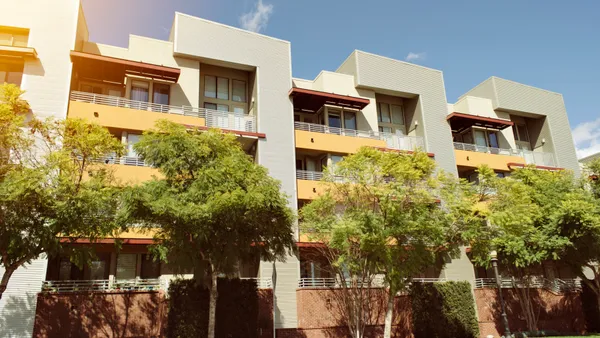Dive Brief:
- The national average multifamily rent has fallen for the second month in a row, down $3 to $1,718 in October, according to Yardi Matrix’s latest national multifamily report.
- At the same time, rent growth has fallen to 0.4% year over year, down 40 basis points from September and a total of 490 basis points since the start of 2023. Growth patterns are split at the regional level, with moderate YOY growth in the Northeast and Midwest and declines in the West and the Sun Belt.
- The U.S. rental market has absorbed 250,000 new units in the first three quarters of 2023 — down from over 600,000 in 2021 but more in line with historical levels. New unit demand remains consistent, although 10 of Yardi’s top 30 markets have seen rents decline as a function of supply growth. The national occupancy rate fell to 94.9%, its first decline in four months.
Dive Insight:
New York City still leads the nation in rent growth at 5.8% YOY, while Austin,Texas, had the steepest YOY rent declines by far at more than 5.0%. Only three regions saw any rent growth on a month-to-month basis: New Jersey at 0.2%, Kansas City, Missouri, at 0.2% and New York City at 0.1%.
Despite these concerns, the report noted that the economy remains strong. The GDP grew by 4.9% in the third quarter of 2023, led by consumer spending, and the U.S. economy has averaged 300,000 new jobs per month through October.
However, high interest rates are an ongoing issue. If rates remain in the 4.5% to 5.0% range, many multifamily properties may face capital gaps when loans come up for refinancing, according to the report.
Still, despite concerns that renter activity may falter if the economy slows, multifamily demand is boosted by other trends, such as the gap in cost between rentership and homeownership.
| Market | YOY rent growth, October 2023 | YOY rent growth, September 2023 | Difference |
|---|---|---|---|
| New York City | 5.8% | 5.6% | 0.2 |
| New Jersey | 4.1% | 5.2% | -1.1 |
| Columbus, Ohio | 3.5% | 2.7% | 0.8 |
| Chicago | 3.2% | 4.0% | -0.8 |
| Kansas City, Missouri | 3.0% | 3.6% | -0.6 |
| Indianapolis | 2.9% | 3.8% | -0.9 |
| Boston | 2.3% | 3.1% | -0.8 |
| Philadelphia | 2.1% | 2.4% | -0.3 |
| Twin Cities | 1.2% | 1.6% | -0.4 |
| Washington, D.C. | 1.2% | 1.2% | 0 |
After the surge in home prices and rents during the COVID-19 pandemic, developers raised new unit production to decades-long highs, raising the pipeline of apartments in development to over 1.1 million. However, Yardi expects new deliveries to fall back in the coming years, owing to the rising cost of construction debt.
“We continue to expect a mild recession will start in late 2023 or early 2024,” Yardi’s revised construction forecast report reads. “The combination of a weakening economic environment, tight financing conditions and record levels of new supply coming online will materially depress new construction activity in the latter part of 2023 and all of 2024. Our baseline forecast for 2026[-2028] has therefore been reduced.”











